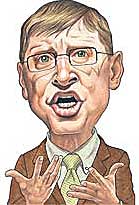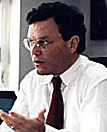
| Spots and Space |
 |
followthemedia.com - a knowledge base for media professionals |
|
|
AGENDA
|
||
“How Can Traditional Media Continue to Charge More For Less?” – Martin Sorrell, CEO of WPP; Heineken Pulls TV Ads in the UK Because of Cost And Other Negative FactorsTraditional media can’t say it is not getting warned. Martin Sorrell, ceo of the world’s second largest advertising agency, has warned that costs cannot continue to grow while audiences delivered are going down.
|
| ftm background |
|
The Bad News for Newspapers Keeps Getting Worse: “Newspaper Revenue Shifts to the Internet” Cries Out One Headline, “Bank Warns Newspapers of Rough 2006” Screams Another “The Advertiser-Dependent Television Model Can Not Survive. Those Broadcasters Who Cannot Resolve This Will Die” – Unilever Global Media Director Overall Global Advertising In 2005 Is Forecast Lower, But the Internet Spend Keeps Going Up With Television Feeling the Worst Pinch of Ad Placements Going Elsewhere Now It’s Confirmed: Some of That Double Digit Internet Advertising Increase Forecast For Each of the Next Five Years Will Come Directly From the Pockets of Newspapers Dutch World Cup Game Watched By 10,000 on the Internet |
It echoes the comments of Unilever’s global media director in September that the advertiser-dependent television model cannot survive. “Those broadcasters who cannot resolve this will die,” Alan Rutherford then told the Royal Television Society.
Sorrell, head of WPP, told the Internet Advertising Bureau Edge 2005 conference that newspapers and television are steadily losing ground to new media, and it will only get worse. He warned where advertisers make their spend is continually changing, indeed changing faster than many people might think. He left little doubt that in his mind traditional media needs to get onto the new media bandwagon as quickly as possible.
“Over the past couple of years I cannot recall seeing a very happy media owner, certainly not of the traditional type. They are all worried about what is going on,” he told the audience.
He particularly mentioned Rupert Murdoch’s spending this year around $1.3 billion for various Internet sites that obviously showed that News Corporation wanted to be a major player on the Internet, but he said their actual strategy was not clear and it resembled panic buying. He also noted that BskyB in the UK, 37% owned by News Corporation with Murdoch as chairman, has announced it is buying the Easynet broadband provider for £211 million, obviously looking at expanding into a broadband delivery system.
That broadband investment would match Bill Gates’ vision of where the Internet is going. The Microsoft chairman spoke at the same conference and said in his view that within the next decade television, newspapers and magazines would all be delivered via the Internet, making television watching, for instance, slave to the viewing times desired by each individual viewer.
He said that in today’s world there was no question “the future of advertising is the Internet,” but he said that argument would disappear as all media eventually migrates to Internet delivery.
Dutch brewer Heineken, meanwhile, has fired a shot that could well be heard around the world – withdrawing its £6.5 million annual UK TV spend that had been aimed at the 18-25-year-old male. The company, which has about a €100 million global advertising budget, says it will now focus more on point-of-sale advertising and sports sponsorship.

And if the television industry needs to hear exactly what its problem is today then it should pay attention to the reasons Rob Marjinen, managing director of Heineken UK, gave for dropping television:
“The enormously cluttered environment in TV ads makes it difficult to make standout ads. It’s also very expensive and it’s questionable as to its effectiveness,” he said.
Heineken still sponsors European Champions League Football and Rugby Union’s Heineken Cup so ads connected to those events will still be seen. But no more clutter ads.
More recently released research indicates a growing trend by advertisers away from traditional media to the Internet, but even so the Internet remains a small fish in the very big pond. According to Zenith/Optimedia, newspaper and television advertising will fall slightly and remain flat for the next two years even though overall global ad spending is expected to increase by 5.2% this year and more than 6% in 2006 and 2007.
Internet advertising in 2005 has about 4.3% of the total global advertising spend and this is forecast to grow to 4.7% in 2006 and 5% in 2007. Newspapers today globally get 30.3% of the global spend, but that is forecast to decrease to 30.1% in 2006 and further drop to 29.8% in 2007. Television, which today gets the lion’s share of the spend at 37.1% will grow to 37.2% for both 2006 and 2007, according to the survey.
The question is whether Zenith/Optimedia has adequately taken into account the warnings by major advertisers that the current television clutter ad environment cannot continue, and also the fears of advertisers to the skipping of more and more advertising as personal video recorders become a household item, and that the Internet is increasingly seen as a very cost effective alternative.
Zenith/Optimedia does note that G7 countries are not leading the advertising growth. The US, because of its shear size, accounts for some 30% of the world’s advertising spend, but the next largest ad growth countries are Brazil, CIS, India, China, Saudi Arabia and Indonesia.

It noted that Brazil, Russia, India and China and the Saudi/Pan Arab region accounts for approximately a third of the growth in global advertising.
The forecast says that for the first time total ad spending this year will top $400 billion.
So the main worry would appear to be not whether advertising will continue at its current pace, but rather where will the spend be directed. And when Martin Sorrell says he sees online and broadband as the future then traditional media should be looking more than ever at their strategies to see how they can gain a big piece of that pie before its all gone.
Sorrell told the CSFB Media Conference in New York that traditional media, to avoid further financial pressures, needs to start charging for some of its content on the Internet.
He said the main problem for traditional media was that it had lost revenue sources that have yet to be made up. Thus, since the readers are off to the Internet for their news and information, and the advertisers are following them, then the media, in chasing those readers on the Internet, needs to start charging for that Internet news and information.
He said that newspapers in particular are just plain giving too much away on the Internet.
And to prove the point that in some circumstances newspapers can charge for Internet content, the New York Times says its TimesSelect online subscription service has added another 60,000 accounts in the past month and now has 330,000 subscribers.
A subscription to the New York Times or the International Herald Tribune carries a free TimesSelect subscription, and the company won’t say how many of the 330,000 are paying the annual $49.95 and how many get the service free with those print subscriptions, but previously the company had indicated 50% of the TimesSelect subscriptions carried the payment.
| copyright ©2005 ftm publishing, unless otherwise noted | Contact Us • Sponsor ftm |